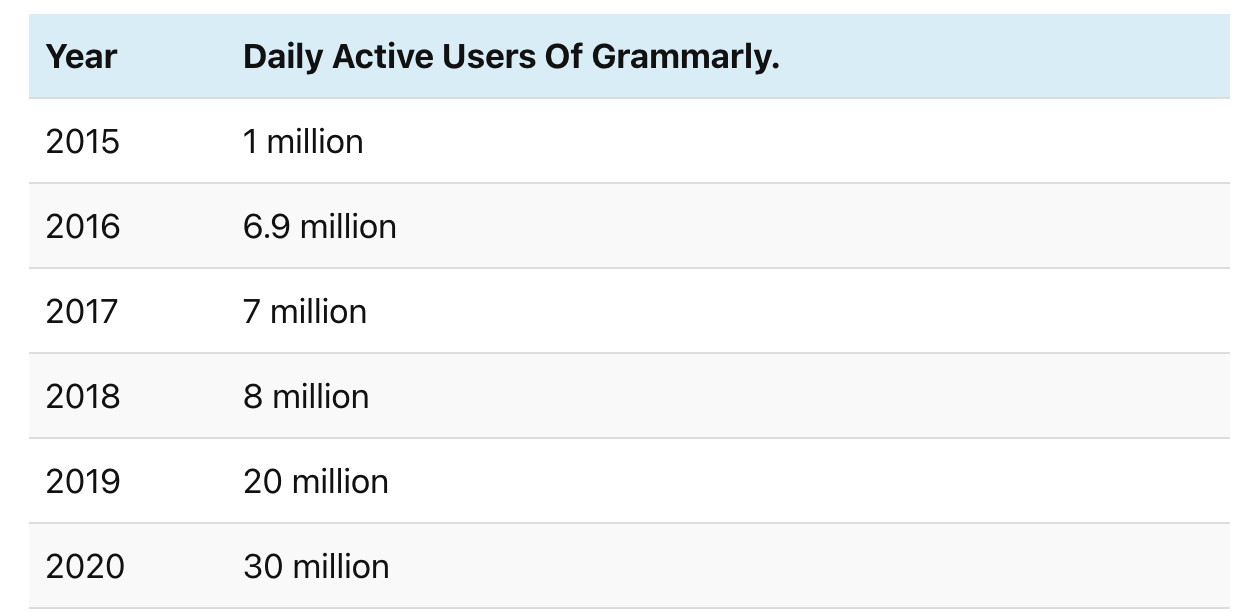When was the last time you got so excited about a product that you couldn’t stop talking about it?

I’m not a native English speaker, but I do love writing. Yet, reviewing my drafts had always been troublesome, and I had many blind spots. Once I heard about Grammarly, I immediately got my Chrome plugin and started using it. I couldn’t get enough of it.
My writing leveled up and I talked to everyone about it. A few weeks after using it, I upgraded to premium. That was in 2017 and since then I’m still an advocate of the tool because it helps me to be a better writer.
Grammarly uses a product-led growth (PLG) strategy focused on reducing time to value, increasing user engagement, and continuously improving its value proposition. Because of this, it has been able to grow rapidly within a five year period:

In this article, you’ll learn more about product-led growth, how it differs from sales-led growth, and how to go about implementing the strategy within your team.
Product-led growth (PLG) is a way of using the product to boost business success and user growth. It focuses on simplifying user acquisition, activation, engagement, and referral.
The core of PLG relies on reducing time to value and relentlessly improving the user experience by creating multiple a-ha moments. Here are a few examples:
The core of PLG is creating a self-sustaining growth engine. Users stay because the product continuously increases value creation, which leads to referrals and organic growth. PLG hinges on five key goals:
Shall we talk about the big question? What about sales?
Product-led growth is a relatively new model compared to sales-led growth. For decades, companies invested significantly in sales teams because that was the standard way to drive customer growth.
Product-led and sales-led have several key differences. The most important are:
PLG and SLG are different strategies with advantages and disadvantages. It’s critical to understand what you aim to achieve and the complexity of your product so you can deploy the best strategy.
I imagine you may wonder about how to bring PLG down to Earth. Let me help you with that.
The first aspect is to understand your current scenario. When a company is sales-driven, moving to PLG will be a considerable shift and journey, yet possible. The critical aspects of implementing PLG are:
PLG isn’t a process; it’s cultural change.
Let’s look at a few companies nailing PLG and how each approaches it.
Note that all the above gives incredible user value for free users, but each has enough premium users to sustain the whole platform.
To measure the success of your PLG strategy, you need to monitor the following:
PLG won’t fit every single product. Some products are complex and require personal interaction. For example, enterprise solutions are highly complex and unlikely to fly without building relationships. Deploying PLG with a complex product will lead to undesired results.
Another common challenge is the transition from sales to PLG. With SLG, salespeople hold the customers and are responsible for growth, but PLG changes that upside down. It requires a cultural change, which can only happen with the full support of the company leadership.
User acquisition costs and monetization are sensitive topics requiring learning to balance. How much value can you give for free so enough users will convert to premium ones? It’s not a science; it’s an art.
PLG means that users will collect value from the product as fast as possible without any strings attached. However, a product-led growth strategy requires cultural change as the product becomes the core of the business.
That said, this isn’t to say that SLG doesn’t have a place. The more complex your product, the more suited it might be for an SLG strategy instead.
Remember, when it comes to PLG, having a way to measure key metrics is essential. It’s useful to think of PLG as more of an art than a process. Good luck!
Featured image source: IconScout

LogRocket identifies friction points in the user experience so you can make informed decisions about product and design changes that must happen to hit your goals.
With LogRocket, you can understand the scope of the issues affecting your product and prioritize the changes that need to be made. LogRocket simplifies workflows by allowing Engineering, Product, UX, and Design teams to work from the same data as you, eliminating any confusion about what needs to be done.
Get your teams on the same page — try LogRocket today.

Most teams fail at autonomy. Learn how clear rules help product teams move faster without micromanagement.

A practical framework for PMs to use AI in ideation without sacrificing judgment, strategy, or decision quality.

A practical five minute revenue estimation method to help product managers compare ideas, drop low impact features, and prioritize smarter.

A practical guide for PMs who want to stop being bottlenecks, delegate smarter, and lead teams effectively with a clear ownership framework.